FREQUENTLY ASKED QUESTIONS
On this page, you’ll find valuable information about using and maintaining your Stirling engine. From care tips to troubleshooting advice and frequently asked questions, everything you need is right here. If you have a question that’s not answered, feel free to get in touch with us.
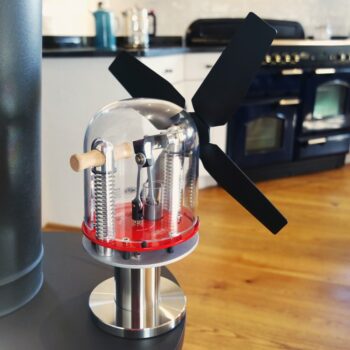
How does a stove fan work?
Warpfive Stove Fans are miniature Stirling engines. They work by moving a sealed volume of air from the hot bottom plate to the cool top plate of the engine. As the air moves from the cool plate to the hot plate it is rapidly heated, it expands and pushes the piston up. As the air is moved from the hot plate to the cool plate it cools rapidly and contracts, this creates a vacuum which pulls the piston down. This same volume of air is rapidly heated and cooled many times per second. As the piston is connected to a crank shaft it causes the crank to rotate and this produces the mechanical power to rotate the propeller.
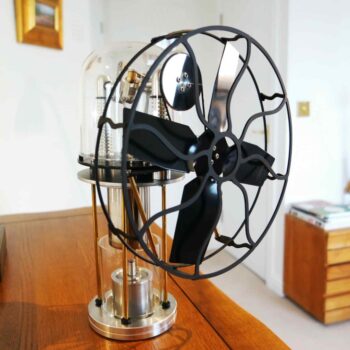
How reliable are Stirling Engines?
Stirling engines are incredibly reliable as they have no electrical components which can burn out. We have test engines that run consistently – see the Stirling engine design page for more information.
Are Warpfive Fans noisy?
No. Operation is quiet – typically 12dB. We use precision bearings and glass piston cylinders to ensure the engine will work quietly.
What is the first step when choosing?
You need to establish the temperature of your stove surface which can easily be done with a Stove Top Thermometer. If you don’t have an accurate thermometer, place a drop of water on the surface – if it bubbles away instantly, you’ll know your surface is above 100 C (212 F). The heat on your stove surface powers the engine which provides the energy to spin the fan blade.
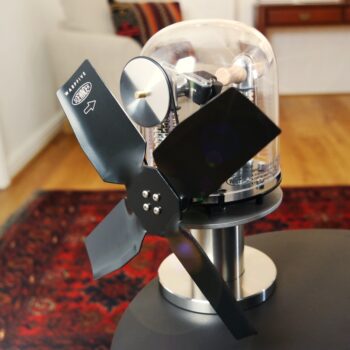
I have limited space above my stove – which engine do I need?
The Warpfive Sidewinder Stove Fan is specifically designed to fit into most restricted spaces. Its overall height is 225 mm (including the fan blade).
Can I use any oil to lubricate my Stirling Engine?
It is important to use our supplied lubricant only because it is a synthetic, high temperature oil specially developed for use in extreme heat environments. Using other oils such as mineral oil or light machine oil, will result in a sticky residue which will damage your engine’s performance.
Can I use a Stirling engine stove fan on a diesel or catalytic stove?
Yes you can. However in order to protect your Stirling engine your should reduce heat transfer. This is done by raising the unit slightly and inducing an air gap. For example you can use 3 washers under the base of the unit. Furthermore your Stirling engine will require lubrication much more frequently.
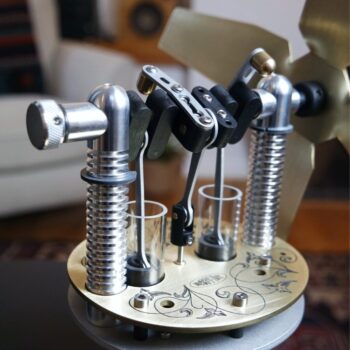
I have a very large room – which engine do I need?
The Warpfive Twinspeed Stove Fan is premium high performance engine with twin piston cylinders. This makes it exceptionally powerful and able to move large volumes of air (in excess of 440 CFM), the perfect choice for a large room.
My new Warpfive Fan has stopped working – what should I do?
If you’re running very hot fires, it will be necessary to tighten the bolts on the top plate much sooner. Please refer to the instructions in your user manual. You will also need to clean and lubricate the displacer shaft more frequently.
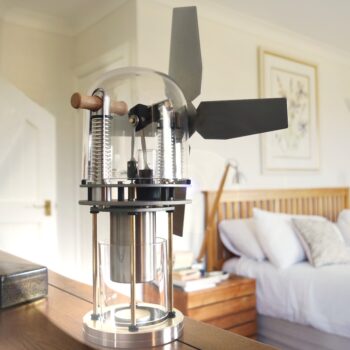
Can I use my dust cover while the Stirling engine is in use?
Yes you can so long as you spin the propeller as soon as it reaches operating temperature to keep the dust cover cool – and follow all other instructions. Refer to the dust cover page for more information.
How do I maintain my Stirling Engine?
Like any engine a Stirling engine requires basic care once every season or after approximately 1000 hours of use. This entails wiping clean and lubricating the displacer shaft with the supplied lubricant. Please see user guidelines for more information. If your engine starts making a ticking noise – this is a sign that it needs to be cleaned and lubricated.
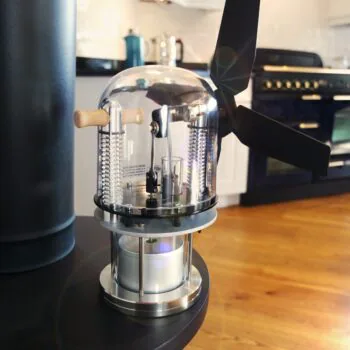
Will a Stirling Engine stove fan work on a pellet stove?
Yes a Stirling engine will work on any surface so long as there is sufficient heat transfer into the base of the engine. All of our stove fans have minimum start up temperatures. If the base of the engine reaches this minimum start up temperature it will work.
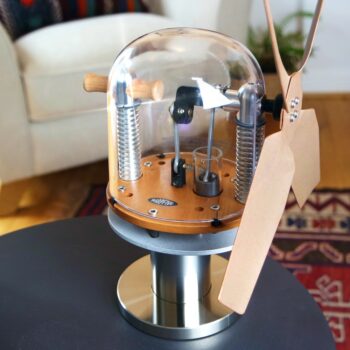
I have more than one Warpfive Fan – why do they function differently?
Every Stirling engine fan is unique. Many factors affect performance differences such as bearing friction, bearing tolerance, bush tolerance, shaft tolerance, alignment, piston tolerance, etc. It’s virtually impossible to have two engines performing exactly the same. Each unit is tested to ensure it meets the minimum start up temperature, however sometimes the start up temperature may be lower. This is why you will notice performance differences if you have two or more Warpfive Fans.
I can’t feel any air movement?
The higher the temperature of your stove surface, the faster your fan will spin. When the room temperature is the same temperature as the air being moved by the fan, it can be difficult to ascertain any movement. Wet the back of your hand with cold water and hold it in front of the engine – this will instantly give you some indication of air movement. Warpfive fan blades have been optimised to move maximum air at low RPM.
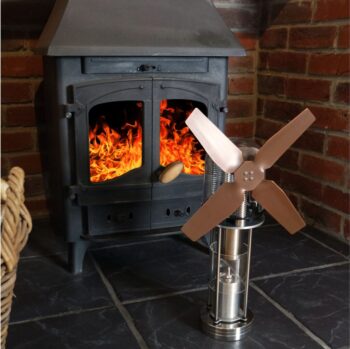
How do I book a service for my fan?
Please contact us for information and pricing.
TROUBLE-SHOOTING TIPS FOR NEW WARPFIVE FAN USERS
Refer to the start up temperature in your user manual. This is the temperature at which the fan blade will begin to spin. The more heat driven into the base of the engine – the faster it will work. In other words, the hotter the surface, the greater the thermal transfer and the quicker the fan blade will spin. To ensure you have sufficient heat on your stove surface – place a drop of water to measure the temperature – if it bubbles away instantly – you’re over 100 C (212 F).
- Ensure you have tightened the grub screw on the fan blade sufficiently. Remove the fan and reattach using the hex key provided. Please note that Stirling engines do not self-start – you will need to flick the fan blade when it is up to temperature.
- Every engine is thoroughly tested to perform as specified prior to shipping. Although we take great care with our packaging – sometimes and highly infrequently – a parcel may be handled roughly and sustain damage. To confirm your engine has not been damaged in transport, place it onto a different heat source, for example your cooker stove top. Heat it up gently and ensure that the blade begins to spin.
- Remember that a dappled / stippled surface or a heat-protected coating will result in a reduction of heat transfer and a lack of performance.
- If you are running very hot fires, it will be necessary to tighten the bolts on the top plate much sooner. Please refer to your user manual for instructions. You will also need to clean and lubricate the displacer shaft more frequently.
Please contact us if you need further assistance.
